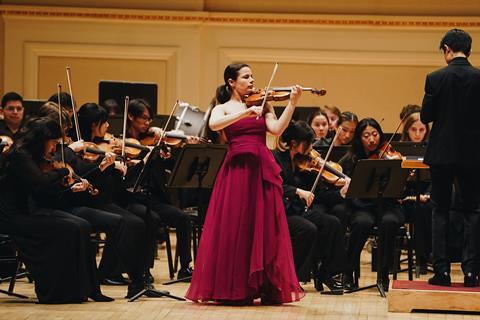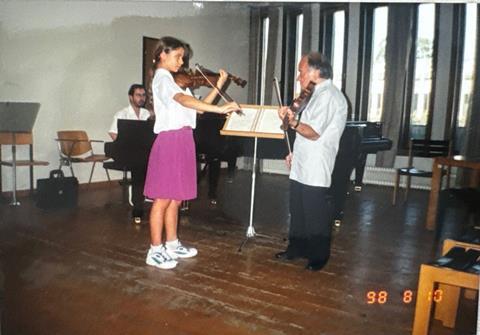Slow practice, positive self-talk and bananas all play a part in Bella Hristova’s preparation for a recent performance of Prokofiev’s second Violin Concerto at New York’s Carnegie Hall

Discover more Featured Stories like this in The Strad Playing Hub
On 26 May 2024, Bella Hristova performed twice at New York’s Carnegie Hall: first in the finale concert of the 2023-2024 Young Concert Artists season and, days later, in a performance of Prokofiev’s second Violin Concerto with the New York Youth Symphony. Here, she shares her preparation strategies.
I first learnt Prokofiev’s second Violin Concerto when I was twelve years old. I vividly remember being mesmerised by a recording of David Oistrakh playing it, captivated by the characters and colours of the piece. Determined to learn it myself, I found the music in the library, brought it to my next lesson, and declared to my teacher that I would be learning it. A few months later, I was in Salzburg performing Prokofiev 2 in a masterclass for Ruggiero Ricci. He asked, ’Have you played Mendelssohn? Bruch G minor?’ My twelve-year-old self replied, ’No, I want to play this one!’ And so we worked on it. This experience marked the beginning of my long history with the piece. Last month, as I prepared to perform it with the New York Youth Symphony and Andrew Kim at Carnegie Hall, I approached it with the same diligence and curiosity I bring to any piece, regardless of my familiarity with it.

At the beginning of each season, I have a rough mental outline of when I should start repertoire to have it ready for my scheduled performances. In this case, I hadn’t played the Prokofiev in a year and started my preparations about five weeks before the performance date. Any time I bring a piece back, I first play through it to remind myself of where things fit, find spots to focus on during my preparation, and get a general idea of what shape the piece is in. My first play-through is more about collecting information than fixing problems. As I had other concerts to play at the end of April, I let that information marinate for about ten days.
This concerto feels very familiar in my hands, but there are always spots that need careful attention, no matter how many times I’ve played them. One of my favourite phrases is the very opening, where the violin starts with a beautiful, reflective melody. That phrase sets the mood for the whole first movement. When I practise it, I look for phrase continuity while showing the shapes of the line, and just the right amount of expressiveness—not to give away too much too soon. Sound quality, continuous vibrato, bow distribution—these are all things that I experiment with during my practice. Especially in a piece that starts with the solo line alone, it’s also important to think through and practise the steps before a sound is made—in this case, ’find the B-flat with your left hand, place the bow on the string, and go!’ Playing that opening at Carnegie felt absolutely magical, and the hall gave back every bit of expression that I put into it.
This concerto feels very familiar in my hands, but there are always spots that need careful attention, no matter how many times I’ve played them
I tend to do a lot of slow practice. For passagework, of which there is no shortage in this piece, slow, thoughtful practice is crucial. Finding the most efficient hand shape, internalising the distance of shifts, deciding whether a note requires a shift or a stretch, knowing exactly when the right hand should cross strings—these are some of the things that occupy my mind during slow practice. Often in difficult left-hand passages, I move the focus to the right hand, which helps greatly. These may seem like simple, fundamental things to practise, but for me this paves the way for the music-making, which becomes so much more enjoyable once the technical problems are dealt with.
There are two spots in this piece that put my mind on extra-high alert. The first one is number eleven, or the top of the third page, or ’that twisty bit’ in the first movement. The other one is the Coda of the last movement, and I often say to myself, ’You got this!’ just before launching into both of them. ’That twisty bit’ needs really tight ensemble between soloist and orchestra, and it feels like one hesitation on anyone’s part can throw the whole thing off. This is the passage with which I keep my hands warm right before I go on stage, with special focus on shifts and string crossings.
In the Coda, numbers 78 and 79 are the same for the first three measures. Yes, but 79 is identical to 77 for seven measures (just in a different key), whereas 78 changes after three measures. Not that I’m counting measures on stage, but finding patterns like these and knowing them in the back of my mind helps me greatly with the memory there. I love the Coda and its staunch character and relentless drive to the end.
This concert was in the early afternoon—2 pm—so I made myself a schedule for the day, mostly to manage my caffeine consumption. Being a coffee drinker, I get headaches if I don’t have any, but jittery if I have too much. (The solution was to wake up at 7am and have half a cup.) I arrived backstage at 9am. My warm-up happened in my dressing room, and my portion of the dress rehearsal was at 10am. I feel very fortunate to live just a few blocks away from Carnegie Hall, so I was able to dash back home between rehearsal and concert, get ready, and arrive back at my dressing room by 1pm. Having at least an hour backstage is ideal for me. I don’t feel rushed; I changed into my gown, warmed up, played through things slowly. I had asked my husband to get me a banana, and he brought me three in various stages of ripeness (love him!). I chose the perfect one, ate it, noodled around some more, and then it was time to play.
Each time I play at Carnegie, I am so inspired by the history and music-making that has happened on stage before me. The hall has a dream acoustic, and there is nothing quite like walking out on stage and feeling the energy of the hall. Playing with these talented young musicians and Andrew Kim was a thrilling and unforgettable experience, and it was a privilege and joy to perform Prokofiev’s second Violin Concerto for the enthusiastic Carnegie audience.
Read: Cellist John-Henry Crawford on Tchaikovsky’s Variations on a Rococo Theme
Read: The road to Wigmore: cellist Sterling Elliott’s practice diary
Read more Featured Stories like this in The Strad Playing Hub
The number one source for playing and teaching books, guides, CDs, calendars and back issues of the magazine.
In The Best of Technique you’ll discover the top playing tips of the world’s leading string players and teachers. It’s packed full of exercises for students, plus examples from the standard repertoire to show you how to integrate the technique into your playing.
The Strad’s Masterclass series brings together the finest string players with some of the greatest string works ever written. Always one of our most popular sections, Masterclass has been an invaluable aid to aspiring soloists, chamber musicians and string teachers since the 1990s.
American collector David L. Fulton amassed one of the 20th century’s finest collections of stringed instruments. This year’s calendar pays tribute to some of these priceless treasures, including Yehudi Menuhin’s celebrated ‘Lord Wilton’ Guarneri, the Carlo Bergonzi once played by Fritz Kreisler, and four instruments by Antonio Stradivari.













































No comments yet